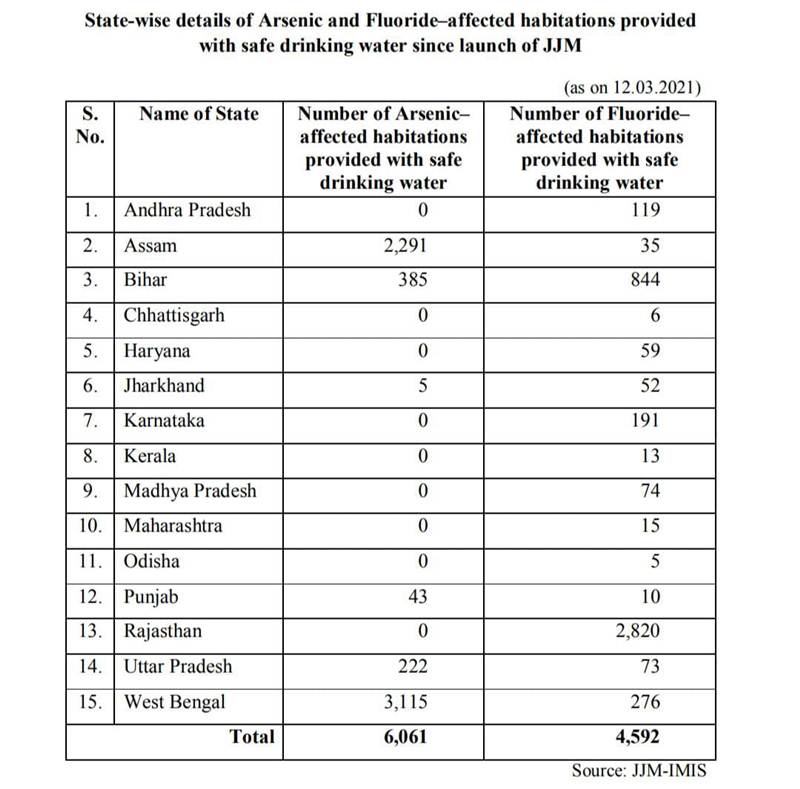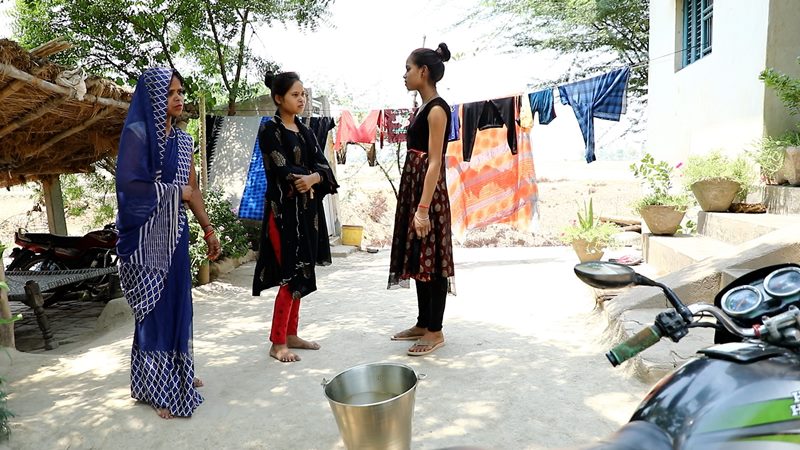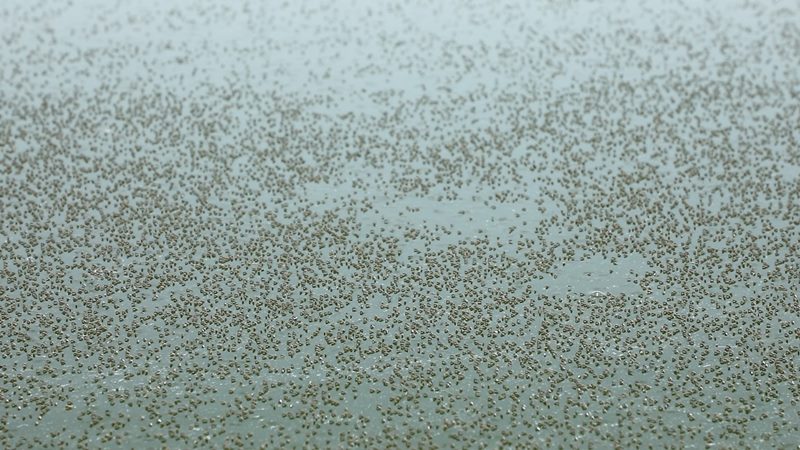Unnao, Uttar Pradesh
Shiv Kumar, along with his family of seven, is leaving behind his ancestral home at Dakari village in Unnao district, 70 kilometres from the state capital, Lucknow.
“I am the third generation that has lived in this house,” said the 54-year-old, resignation and sadness in his voice as he prepared to depart the home where his grandfather and father lived and breathed their last, and where he himself grew up.
Water is the reason why Shiv Kumar is moving home and hearth to another village. The highly contaminated quality of water, he said, was driving them away.
UP Jal Nigam, Unnao’s water quality test report for Sikandarpur Karam block, where Shiv Kumar’s village is located, showed total dissolved solids (TDS) level of 4,089 milligram per litre (mg/l) against the desirable limit of 500 mg/l. Total hardness of water was found to be 2,072 mg/l as against the desirable limit of 300 mg/l.

Consuming water with high fluoride or arsenic leads to a number of health problems including fluorosis, a crippling disease. All photos: Gaon Connection
“Not potable for TDS, chloride, hardness, alkalinity,” reads the water quality report dated May 28 this year. Gaon Connection has a copy of the test result.
Shiv Kumar’s family is not the only one which is migrating because of lack of safe drinking water. “Other members of the extended family have already left the village. I was hoping things would change, but nothing has,” Shiv Kumar said as he loaded his last piece of luggage onto the tractor that would carry them away from his ancestral home.
Shiv Kumar’s Dakari village in Unnao is one of the hundreds of villages in Uttar Pradesh that is affected due to a cocktail of contaminants in their groundwater — the only source of drinking water for millions (see map).

Poison in groundwater
As per the 2019 data of the Department of Drinking Water and Sanitation, of the total 75 districts in the state, 63 districts have fluoride above the permissible limit and 25 districts are affected by high arsenic . Groundwater in 18 districts of the state has both high fluoride and arsenic.
The Bureau of Indian Standards’ (BIS) Drinking Water Standards IS 10500:2012 specifies an ‘acceptable’ limit of fluoride in drinking water as 1 milligram per litre (mg/l), but in the absence of a safe water source, the ‘permissible’ limit of fluoride is 1.5 mg/l.
Similarly, for arsenic in drinking water, the permissible and acceptable limits are 0.01 mg/l and 0.05 mg/l, respectively.
But, some districts, such as Baldeo block in Mathura district in UP, have reported fluoride levels up to 5.9 mg/l, as recorded in the Ground Water Year Book 2019-20 prepared by the Central Ground Water Board, under the Union Ministry of Water Resources.

High fluoride in groundwater has been reported in several states of the country. A March 2021 research article published in the Indian Journal of Public Health points out how fluorosis is a major public health problem in 20 states of India.
In a written reply (March 18, 2021) to a parliament question, Gajendra Singh Shekhawat, the Union minister for Jal Shakti informed how in 2017, there were 27,544 arsenic/fluoride habitations in the country, which the government has been trying to provide potable water.
According to the Union minister’s reply, “except 1,386 habitations, potable water is now available in all these habitations.”

Consuming water with high fluoride or arsenic leads to a number of health problems including fluorosis, a crippling disease; and arsenicosis (also linked to cancer), respectively.
“High fluoride water harms the teeth and gums, causes skin-related problems and over the years affects the bones,” Alok Pandey, physician at the Unnao district hospital, told Gaon Connection.
Pandey also added that high fluoride could affect a person’s vision. Children, he said, were more vulnerable to the adverse effects of fluoride in the water sources and it reduced their immunity.

Poor quality of water is forcing many residents to leave their village homes.
Exodus from Dakari
According to Chak there are approximately 257,672 people living in the 4,355 villages in 1,445 gram panchayats of Unnao district. Of them, 1,427 villages were found to contain high amounts of fluoride — between 2.20 mg/l and 4.20 mg/l — in their groundwater according to the testing lab of the state.
“It is poison that comes out of the handpumps, not water,” said Shiv Kumar, resident of Dakari village with a population of 609.
“There is discharge of chemical laden water from the leather tanneries nearby. And, every day the water in our village is getting more and more polluted,” Raghavendra Singh from Dakari, told Gaon Connection. Something in the water is so corrosive that it is eating into the metal of the handpumps and taps, he added.

Tanneries from the neighbouring Kanpur district are cited to be one of the contributing factors for the toxicity in Unnao’s water supply.
The district authorities aren’t unaware of the pilght of Dakari residents. About two decades back, the government laid a pipeline all the way from Poni village about five kilometres away from Dakari. It is meant to supply clean water to the village.
“But because of old, rusted pipes, the water barely makes it to only one or two taps in the common public areas in Dakari. The supply is just once a day at six in the morning, for just one hour and we manage to get only about eight to ten litres from it,” Raghavendra complained. The rest of the water needs of villagers are met through the contaminated groundwater.
“We are helpless and therefore have to drink this very same water knowing fully well it cannot be good for our health,” Shanti Devi, who sat scrubbing vessels at a handpump, told Gaon Connection. “When we are really thirsty, we drink a glass or two of the foul smelling water and then wash it down with the good water we buy,” she added.

Shanti Devi said that if the water quality did not improve, her family too will have no other alternative than to leave the village.
Shanti Devi said that if the water quality did not improve, her family too will have no other alternative than to leave the village. “The water is yellowish and as a result the clothes we wash in it get discoloured; vessels turn black and the floors at home also get a dirtyish hue,” she complained.
Those who can afford to, are leaving these villages. But what happens to a large chunk of the village population that cannot leave behind its homes and has nowhere to go?
Also Read: Community-driven action reduces incidence of fluorosis in Miyati, Madhya Pradesh

Bitana Devi (red saree) and other villagers continue to worry about the water issues in their villages.
Sickness in every drop
Sixty-five-year-old Indrana came to Raghunath Kheda village of Unnao some 40 years ago after her wedding. The young bride did not know what was in store for her.
“Back then, the water was fine and so was my health. It is in the last ten years that the quality of water has become terrible and along with it I began experiencing trouble with my back,” Indrana told Gaon Connection. And as she stood up from beside a water trough meant for cattle, it became apparent that she was bent over double.
According to Indrana it was not just her, many other men and women in Raghunath Kheda village (1,200 population), about 10 kilometres away from Dakari village, suffered from misshapen bones. All she knew, she said, was that till 10 years ago, the water was fine and so were her bones. But not anymore.

Drinking high fluoride watsre leads to fluorisis which affects the bones.
Like Indrana, 38-year-old Manju Devi also said that when she came to Raghunath Kheda after her wedding 20 years ago, there were no problems with the water. “Now, I feel like throwing up even if I rinse my mouth with the water,” she told Gaon Connection. I cannot remember when I last drank sweet water to my heart’s content, she said sadly.
“I am constantly unwell. I struggle to sweep the floor on account of painful knees, a bad back,” Manju Devi said, blaming the contaminated groundwater of her village.
Her family buys water from an RO (reverse osmosis) plant for cooking and drinking; the floors of her house remain dirty no matter how much they are scrubbed, and their handpump is completely eroded.

Nearly 20 years back, there were no problems with the water in the villages, said Manju Devi (blue saree).
Meanwhile, Sishupal Yadav from Raghunath Kheda complained that people had stopped visiting their village, and if anyone did visit, they brought water along with them.
Yadav told Gaon Connection that villagers go to other villages to fetch 15 to 20 litres of water to be used by the entire family. “We pay twenty rupees for the water, and spend about the same for the petrol to go there and bring water home,” he said.
Why high fluoride in groundwater?
“One reason for the high incidence of fluoride in the groundwater is because of the geographical lay of the land; it is naturally occurring there in the aquifers,” Mohit Chak, executive engineer of Unnao’s water board, told Gaon Connection.
When Gaon Connection enquired about the poor quality water coming from the handpumps, Chak said that the uppermost layers from where the handpumps drew their water, were the most vulnerable to contamination as effluents easily leached into them. Water taken from below the depth of 300 metres was found to be safe for drinking, he said.
But, he acknowledged that toxic effluents being discharged from the many leather tanneries in the district had a big role to play in contaminating the groundwater in the surrounding areas.

Contaminated water body with mosquitoes.
There are other reasons too. As many as 71 drinking water schemes were introduced in the district about 25 years ago, informed the executive engineer. “These were schemes that were designed to last for not more than 15 years. So, most of the schemes are defunct now, or not running on full capacity,” he pointed out.
Villagers complain they have no knowledge of the water quality of the handpumps that are their only sources for drinking water. “Many times people who test the quality of the water have taken samples of the village water. But no one came back to tell us what they found in it,” Sishupal Yadav from Raghunath Kheda told Gaon Connection.
Chak responded: “The results of the testing are uploaded onto the ejalshakti portal and anyone can have access to it and find out the results,” he informed.
Jal Jeevan Mission to clean up water woes
The central government’s Jal Jeevan Mission Yojana will reactivate the older drinking water schemes, Chak informed Gaon Connection. This scheme of the Ministry of Jal Shakti promises piped water for every household in India by 2024.
“The work to provide potable water to every household in Unnao district will start soon,” assured Chak. And, the new tubewells that will be installed under the scheme will draw water from below 300 metres, he said.
But, till that happens, villagers like Sishupal Yadav continue to worry. “People hesitate to give their daughters in marriage to our boys. They do not want to send their girls to a village where the water is rotting and cripples people for life,” he said.
*Original article online at https://en.gaonconnection.com/unnao-water-pollution-groundwater-fluoride-arsenic-uttar-pradesh-bones-diseases-cancer-deaths-migration/
